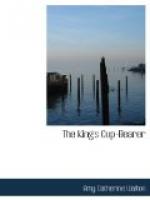What city did the Persian kings make their capital? Not Babylon, with its mighty walls and massive gates, but Shushan, the City of Lilies. They chose it as their chief city for three reasons; it was nearer to their old home, Persia, it was cooler than Babylon because of the neighbouring mountains, and lastly, and above all, it had the best water in the world. The water of the river Choaspes was so much esteemed for its freshness, its clearness, and its salubrity, that the Persian kings would drink no other; they had it carried with them wherever they went; even when they undertook long warlike expeditions, the water of the Choaspes was considered a necessary provision for the journey.
The City of Lilies, in the days of the Rab-shakeh, was a perfect fairy-land of beauty, surrounded as it was by fruit-gardens and corn-fields; the white houses standing out from amongst dark palm trees, and the high walls encircled by groves of citron and lemon trees. As the Rab-shakeh walks along the air is scented with their blossoms, and with the sweet fragrance of the countless Shushan lilies, growing beside the margin of the sparkling rivers.
Above him, in the midst of the city, stands his lordly home. It may well be a magnificent place, for it is the palace of the greatest king in the world, the mighty King of Persia. The palace in which the Rab-shakeh lives is not the old palace in which Daniel stayed when he visited Shushan; it is quite a new building, built only forty years before by the great Ahasuerus, the husband of Queen Esther. It was to celebrate the opening of this gigantic palace that the enormous and magnificent feast of which we read in Esther i., was given by the Persian monarch, who was its founder.
This new palace was built on a high platform of stone and brick, and the view from its windows of the green plain, of the shining rivers, of the gardens filled with fruit trees and flowers, and of the snow-clad mountains in the distance, was magnificent in the extreme. In the centre of the palace was a large hall filled with pillars, one of the finest buildings in the world, and round this hall were built the grand reception rooms of the king.
The ruins of Shushan, the City of Lilies, were discovered by Sir Fenwick Williams in the year 1851, and the bases of the very pillars which supported the roof of the great Rab-shakeh’s splendid home may be seen this very day on the plain between the two rivers.
But who was this Rab-shakeh, and how came he to live in the most glorious palace in the world? He was a Jew, a foreigner, a descendant of those Jews whom Nebuchadnezzar took captive, and carried into Assyria. Yet, although one of an alien race, we find him in one of the highest offices of the Persian court, namely, the office of Rab-shakeh.
This word Rab, so often found in the Bible, is a Chaldean word which means Master. Thus, in the New Testament, we find the Jewish teachers often addressed by the title Rabbi, Master. But the title Rab was also used in speaking of the highest officials in an Eastern court. Three such titles we find in the Bible:




